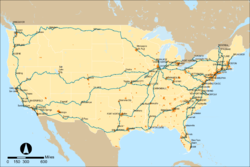Amtrak

Geographic map of the Amtrak system
|
|
| Reporting mark | AMTK, AMTZ |
|---|---|
| Locale |
|
| Dates of operation | May 1, 1971–present |
| Predecessor | 20 privately operated intercity passenger rail systems |
| Track gauge | 4 ft 8 1⁄2 in (1,435 mm) standard gauge |
| Electrification |
|
| Length | 44 routes: 21,300 miles (34,000 km) Track owned: 730 miles (1,170 km) |
| Headquarters | Union Station, Washington, D.C. |
| Website | www.amtrak.com |
The National Railroad Passenger Corporation, doing business as Amtrak /ˈæmtræk/, is a passenger railroad service that provides medium- and long-distance intercity service in the contiguous United States. Founded in 1971 to take over most of the remaining U.S. passenger rail services, it is partially government funded yet operated and managed as a for-profit corporation.
Amtrak serves more than 500 destinations in 46 states and three Canadian provinces, operating more than 300 trains each day over 21,300 miles (34,000 km) of track. Some track sections allow trains to run as fast as 150 mph (240 km/h). In fiscal year 2015, Amtrak served 30.8 million passengers and had $2.185 billion in revenue, while employing more than 20,000 people. Nearly two-thirds of passengers come from the 10 largest metropolitan areas; 83% of passengers travel on routes shorter than 400 miles (644 km). Its headquarters is at Union Station in Washington, D.C.
The name "Amtrak" is a portmanteau of the words "America" and "trak", the latter itself a sensational spelling of "track".
From the mid-19th century until about 1920, nearly all intercity travelers in the United States moved by rail. Historically, U.S. passenger trains were owned and operated by the same privately owned companies that operated freight trains. About 65,000 railroad passenger cars operated in 1929.
From 1920 into the later 20th century, passenger rail's popularity diminished and there was a series of pullbacks and tentative recoveries. Rail passenger revenues declined dramatically between 1920 and 1934 because of the rise of the automobile. In the same period, many travelers were lost to interstate bus companies such as Greyhound Lines. However, in the mid-1930s, railroads reignited popular imagination with service improvements and new, diesel-powered streamliners, such as the gleaming silver Pioneer Zephyr and Flying Yankee. Even with the improvements, on a relative basis, traffic continued to decline, and by 1940 railroads held just 67 percent of passenger-miles in the United States.
...
Wikipedia
